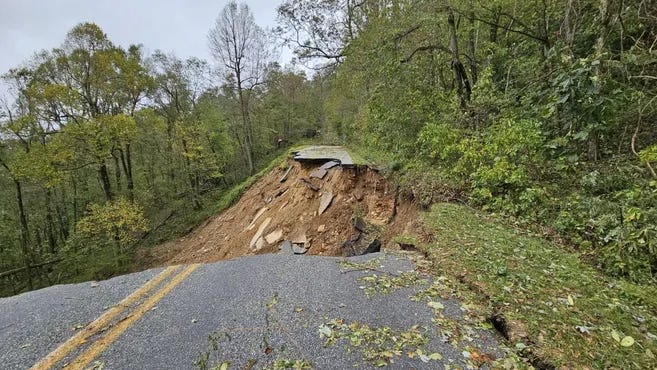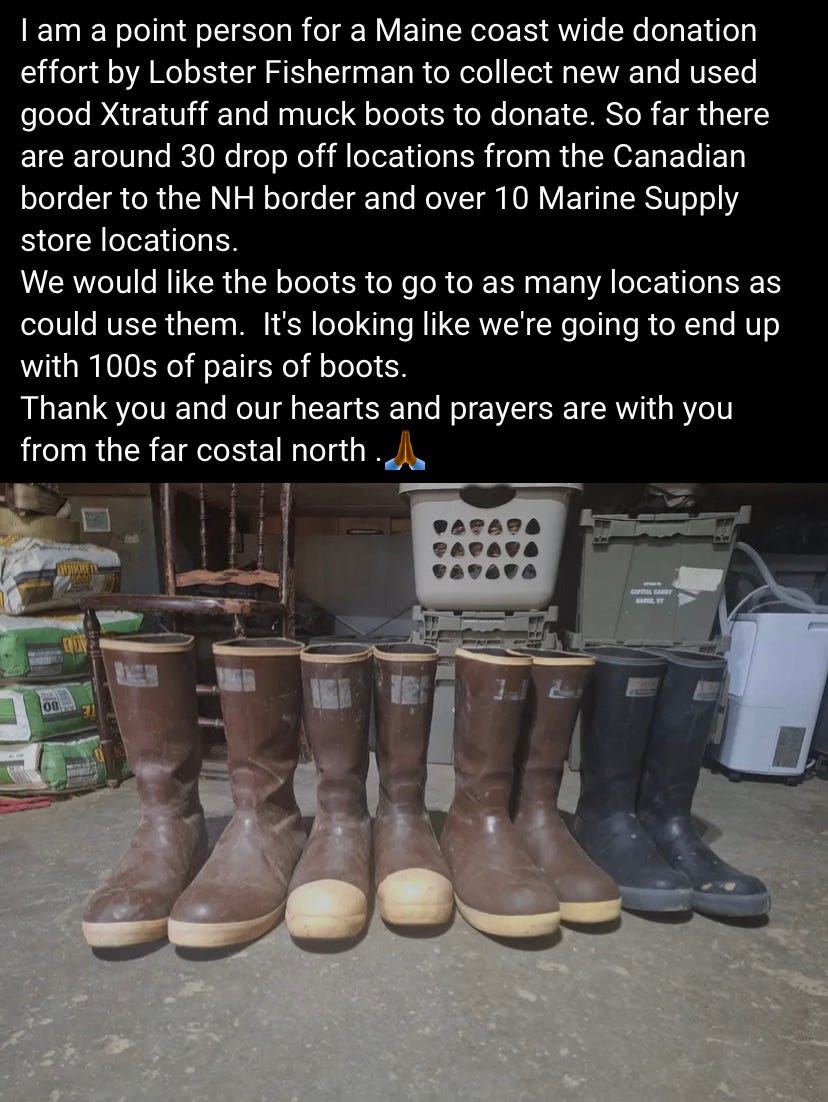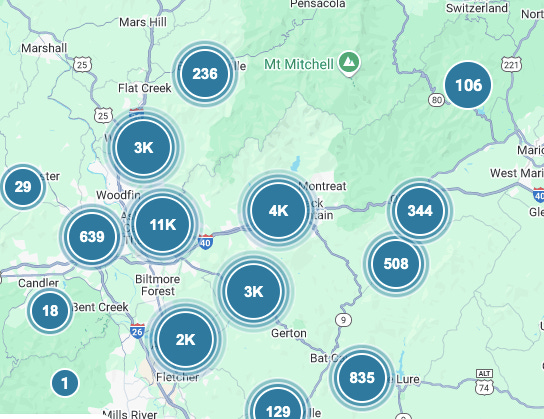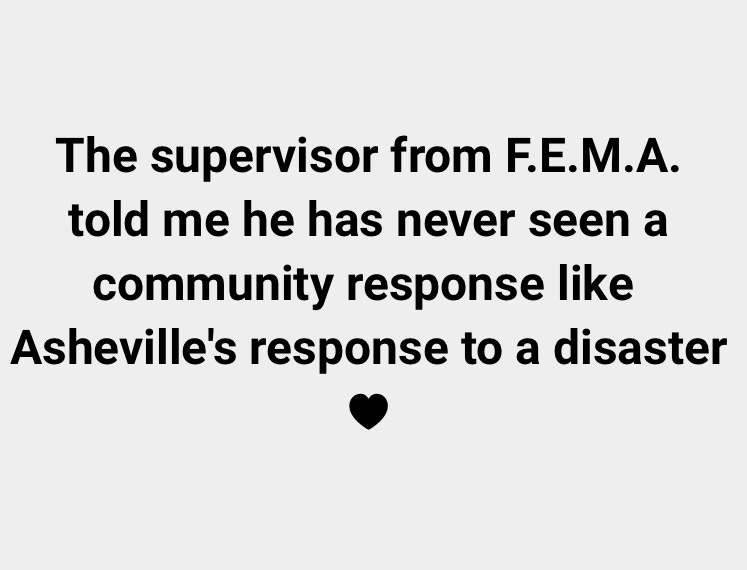
Most Octobers, WNC welcomes scads and scores of tourists to take in the gorgeous fall colors, to stay in our vacation rentals, to sip beer at our breweries and wine at our wineries, to hike in our mountains, camp by our rivers, eat at our barbecue joints, taco trucks, and ramen bars, and gift shop in our quirky little villages. Many businesses and their employees rely on this autumn tourist surge to get them through the winter.
Not this year, though. The leaves are indeed turning, though a lot of them were already on the ground from the high winds and knocked-down trees. But our towns are in shambles, our roads are turned to rubble, power outages are still being worked out, and public water systems are still offline. Travel throughout most of WNC is officially restricted to “essential travel only,” and only five of our counties are open for tourist business. (Graham, Clay, Cherokee, Macon, and Swain Counties, that is. Pay them a visit if you can!)
And maybe not next year, either. Sure, some areas will hopefully be recovered enough to host tourists by next October, but it’s hard to imagine that the entire region will.
The Blue Ridge Parkway is closed and will remain closed indefinitely. Biltmore Estate, one of our top tourist attractions, has suffered significant damage. Earlier this week I visited Swannanoa to drop off a load of propane heaters. The town looks broken in pieces. Much of downtown Marshall, which had experienced a vibrant resurgence in the past few years with all kinds of exciting new small businesses opening up on Main Street, will not be safe for occupancy until extensive work is done. In a town just northwest of me, Hot Springs Spa and Resort has lost most of their outdoor spring-fed tubs and a couple buildings to the flood.
And then some towns, like Chimney Rock, need to be entirely rebuilt from the ground up.
When we say that this is going to be a long recovery—perhaps years-long—this is part of what we mean. It’s not just the sheer level of destruction wrought by Helene, it’s also the massive hits we took to our main source of industry and income. Industry and income that we kind of need in order to recover. And this just a couple years into recovering from the tourism dry spell during COVID.
How does WNC move forward from here? Will we see a mass exodus of unemployed tourism industry workers from our region? Will our small businesses be able to get the insurance settlements and/or investments they need to rebuild?
There’s no telling for sure. But I think we will recover, slowly but surely, if only by our grit and determination, powered by the steam of our love for this place and its people.
12 million cubic yards of debris
The Army Corps of Engineers has been tasked by FEMA with solving the region-wide storm debris problem: the trees, brush, branches, building materials, road surface materials, trash, and everything else that got washed away or blown down in the storm. This is in addition to the work the Corps is doing with local governments to repair infrastructure.
They have assessed the problem and calculated that there are 12 million cubic yards of debris to be cleaned up. That’s a lot. It seems an unfathomable amount, but if you’d seen some of the places that got hit with the worst flooding and mini-tornadoes, you’d understand. One town I visited this week, which hadn’t seen much in the way of an official response yet, had used shop brooms and rakes to push everything into huge piles on the side of the main street so vehicles could get through.
Yesterday, driving in Asheville, I saw a temporary debris collection site set up on a small section of public property. There will probably be many of these popping up across the region since the dumps and landfills can’t accommodate the surplus refuse.
Muck Boots from Maine
One of the best stories I’ve heard this week is about lobster fishermen up in Maine collecting muck boots to send down for our clean-up efforts. It’s so perfectly apt. Maine fishermen saw from afar a need that they were uniquely qualified to fill, and they got to work and filled it.
I don’t care what you heard on the news this election season. This is America, y’all. This is love.
Power Outage Updates
Many Asheville neighborhoods had power restored within the past few days, but there are still widespread power outages around the region. Here are the updated outage maps from French Broad Electric and Duke Energy:
As you know if you’ve been following my updates, one of the biggest concerns right now is keeping people in power outage areas warm as our nighttime temperatures begin to drop.
This past week I delivered two loads of propane heaters and propane tanks (19 heaters altogether) to communities in need, and sourced several donations of seasoned firewood. This coming week I’ll continue this effort, working with my contacts in some of the most isolated communities without power. It’s kind of small beans in comparison to the amount of need that exists, but every bit helps.
I’ve heard that many of the generous people, organizations, and churches who have been steadily sending donated supplies from out of the area have heard about the need for portable heaters and fuel and are including these items in their next shipments. So I expect we’ll get it done before the first freeze, with a little help from our friends.
The best possible FEMA response
I can’t verify this, but I have heard it secondhand from several community members and local first responders who are privy to conversations being had between government agencies and NGOs. FEMA has been blown away by our local disaster response. I saw this share being passed around on Facebook, for instance.
For context, recall that we had zero FEMA presence for the first five days. That’s according to FEMA’s own admission, as well as the reports of community leaders in the worst-hit areas. No one—FEMA or anyone else—could make it here by land in those first few days because the roads to get here were gone.
The thousands of rescues—400 in the town of Black Mountain alone—that occurred in those first critical hours and days were the work of local volunteers working alone, in spontaneously formed groups, or in concert with local emergency services and law enforcement, with the help of a few private sector specialists who made it here with helicopters as soon as they could.
Once FEMA and other agencies arrived, they took some time to do their assessments and set up their bases of operations. All this time, Appalachians were responding, rushing around like platelets to staunch a bleeding wound.
I say this is the best possible FEMA response because it acknowledges how powerful and capable we are as individuals and communities to take care of each other, to shoulder responsibility even in times of extreme duress, and to find workable solutions to real problems without waiting around for Someone to Do Something.
Yesterday I dropped off a load of firewood in a community where the flooding was severe and all the bridges were destroyed. I had to cross a bridge that had been torn asunder by raging flood waters. This bridge was the only way out for the people who lived on that road, and the neighbors weren’t about to settle for being stranded for weeks. So a few guys who lived on the road brought their excavators down (I told y’all practically every holler has like three dudes who own excavators) and reassembled the bridge into some sort of load-bearing structure with the help of tree trunks and packed dirt. It’s pretty solid. As of yesterday, the community still has not heard from the DOT about a permanent fix.
This type of thing is happening in hollers and neighborhoods and apartment buildings all up and down the mountains. Appalachians are feeling emboldened by this surge of voluntary cooperation and the real evidence in front of our eyes that it works. There’s still so much work to be done, but like I said in the beginning, Appalachia has got this.
Thank you all from the bottom of my heart for your donations, your prayers, and the love you have shown us southern Appalachians over the past week. If you would like to donate to a trusted relief effort and make sure 100% of your donation goes to the people who need it, consider the organizations on this list.
My family and I are safe. We are blessed. We were about as prepared as we could have been, in terms of food storage and the ability to survive without modern conveniences for a few days.
Although we were more fortunate than many of our neighbors in terms of property damage and access to needed supplies, this disaster has impacted my ability to earn income and pay the bills. If you feel so inspired, you can help me get through this by becoming a paid subscriber to this Substack for $5/month or making a one-time contribution through the Buy Me a Coffee link below. I am publishing updates on Helene recovery in southern Appalachia twice per week. In addition, my Prayer of the Week comes out each Sunday and I am working on new content focused on spirit-filled, heart-centered responses to the wider dystopia.








I read this to my perennially offline husband. His words:
"Boots on the ground do more than suits on the ground."
I have a friend in Raleigh whose company runs hurricane relief programs in NC, her son flies copters. It’s amazing how many private resources people have at their disposal, and their selfless nature as they continue to help at their own expense.